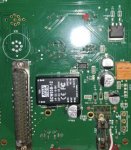halobender
Member
- Location
- Missouri, United States
I have a blown wire wound resistor that I need to determine the value of. Sadly no schematics are available.
Physical size 5.77mm dia, 16.10mm len. Axial through hole. Flame retardant green.
Part of 12v 250ma circuit.
Physical size 5.77mm dia, 16.10mm len. Axial through hole. Flame retardant green.
Part of 12v 250ma circuit.

